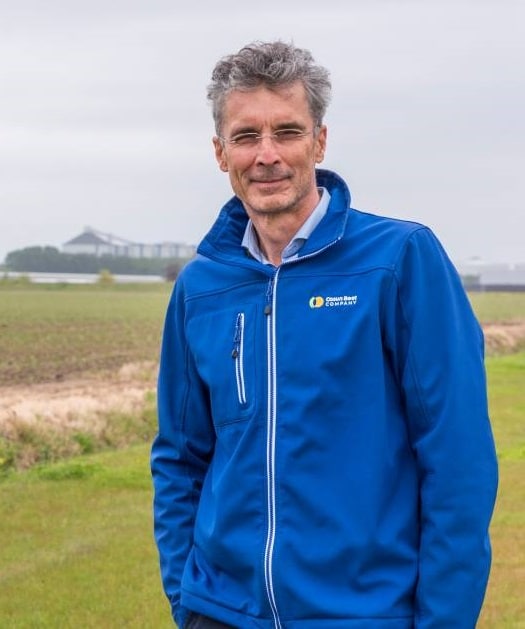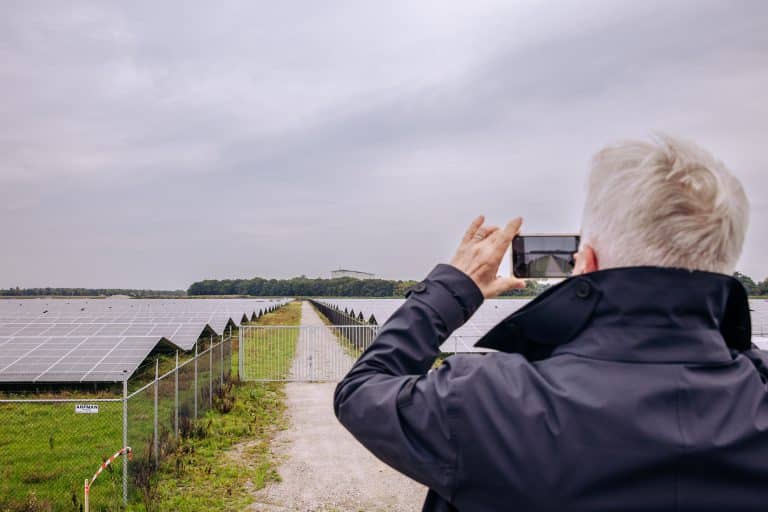‘The idea for the solar park was part of a much larger zoning plan,’ Paul begins. The former sugar factory on the 110-hectare site was closed at the end of 2004. After the new zoning plan was finalised in 2018, the development of the site could begin in earnest. ‘The approach to the redevelopment of the site was not only to generate new business activity, but also to make the site sustainable for the future. That’s how we ended up creating a solar park on part of the site.’
Unveiling
The solar park was officially unveiled on Friday 23 September. As the solar panels have been generating power since last year, Paul deliberately uses the term ‘unveiling’ rather than ‘opening’. The COVID-19 pandemic and all the disruption it caused meant the original opening date had to be postponed. The unveiling took the form of a seminar with stakeholders and residents from the immediate area. After the seminar, other residents of the village were also given the opportunity to visit the solar park. Although local stakeholders were aware that there was a solar park somewhere, now was the first time they could properly see it from the viewing platform located above the embankment. ‘That’s also exactly what we wanted: a solar park that can offset* our factories’ power consumption while having zero impact on the environment,’ says Paul.
Two parts
The park is divided into two parts. One part, covering net 7 hectares, is owned by Cosun Beet Company and supplies power directly to the adjacent speciality factory. The other part of the park, covering about 10 hectares, is operated by Klimaatfonds Nederland (a Dutch investment fund aimed at promoting Dutch solar power) and feeds power directly into the grid. Although Klimaatfonds Nederland leases the land from Cosun Beet Company, it owns the panels. This collaboration came about through KiesZon, which built the arrays. KiesZon develops, finances, constructs, and operates large-scale solar power projects like this one with the aim of accelerating the transition to renewable energy. The green electricity generated by the project in Puttershoek will save 14 million kilograms of CO2 annually.
Social validity
Cosun Beet Company’s part of the park generates enough electricity on an annual basis to power both the adjacent speciality factory and the speciality factory in Roosendaal. However, not all the power generated by the panels can be used immediately by the speciality factory. The solar panels generate power in peaks and troughs throughout the day, depending on the strength of the sun, while demand from the factory is more constant. The factory also runs at night, when the panels aren’t generating power. Some of the products from the speciality factory are therefore produced using green electricity. The remaining power is fed directly into the grid, including to the other speciality factory in Roosendaal. This means Cosun Solar Farm’s simultaneity factor – the degree to which generated power can be used immediately – is between 35 and 40%. In the future, when storage technologies such as batteries have come on, that simultaneity factor might increase. For now at least, Paul doesn’t think it’s a missed opportunity: ‘We have to start somewhere, and we’ve now got the ball rolling by building the first large solar park on the Hoeksche Waard island. Whether you consume renewable energy all by yourself or supply it directly to the grid, its social validity is clear. Because as a company, you’re delivering on sustainability.’ Paul is aware that lots of things need to be optimised in the energy transition: ‘We still have many steps to take as producers and consumers of energy.’
Future plans
Paul doesn’t want Cosun Solar Park to be his last renewable energy project on or near Cosun’s sites. ‘It’s important for Cosun to look at opportunities to generate renewable energy on its own sites.’ Wind turbines combined with a solar park could offer an opportunity to increase the simultaneity factor of green energy – the ability to harness energy directly while you’re generating it – and make a site even more energy-independent. This could be further supported by batteries that store solar energy during peak sun hours. ‘We should seize every reasonable opportunity to become more sustainable. And while we do, we should leverage local opportunities as much as possible and connect directly to our own operations and electrical connections.’
Simultaneity factor
Cosun Beet Company’s 7-hectare solar park produces about 9000 MWh per year. The speciality factory consumes around 6000 MWh, which leaves 3000 MWh for energy accounting purposes and means the factory runs energy-neutrally for energy accounting purposes*. In practice, however, the power generated by solar panels never precisely matches a factory’s energy needs. While the factory runs 24 hours a day and has a fairly constant energy requirement (except on weekends), the solar panels deliver in peaks and troughs. In the current situation, the simultaneity factor – the factory’s use of energy at the same time that energy is generated on the solar park – is 35 to 40%. Part of that energy is therefore consumed directly by the factory, and the rest is fed into the grid through the factory’s electrical connection. In the future, when there are cost-effective options for long-term energy storage, this simultaneity factor may increase. Generating green power locally and using it directly has an added advantage: if there are other users nearby (like in Puttershoek), you generally don’t have to burden the regional energy grid as much.


